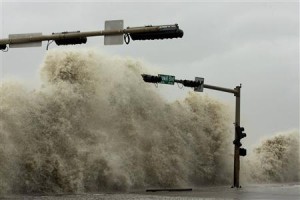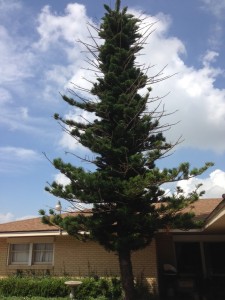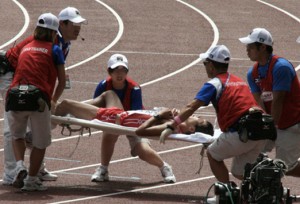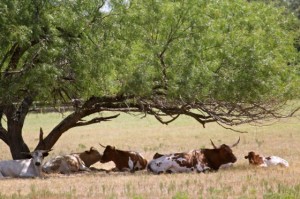I should probably stop reading Texas stories by authors not from Texas. I keep stumbling over all these little bitty minor things that just throw me right out of the story. And they really are minor. Not important to the actual story–just to the Texas-ness of the story. To the feel and reality of the setting.
Do I really have to go back to the distance thing? Really? Fort Hood is between Waco and Austin, wrapped around Killeen and Copperas Cove. Killeen is where they’re having the trial for the Fort Hood shooter guy. Or where all the reporters are staying, anyway. Copperas Cove is where Heisman Trophy winner Robert Griffin III (fellow Baylor Bear) is from. It is pretty close to Austin–maybe an hour’s drive away, and the same to Waco. (Waco is in that 200,000 population range, remember.) It is not close to Dallas. It’s over 2 hours’ drive away. More, if you have to drive through Dallas because your small town is north of the big city. Texas has a lot of big cities. Authors should take a look at a map and see which ones are near your mythical location. And maybe take a little look at the size of towns.
However, this blog is going to be about the Texas climate.
Most people understand that Texas is hot. But a lot of them don’t seem to realize just what that means. One thing it means is that summer lasts a really long time. My daughter grew up in central Texas. After her marriage, she and her husband both went to Carnegie-Mellon University in Pittsburgh–the one in Pennsylvania, not the one in East Texas–to earn their doctorate degrees. And every year in August she complained, because August was not the hottest month of the summer. It was already starting to cool off there in Pennsylvania, and that, according to her, is just wrong.
In Texas, August is unbearable. It’s the hot month. It’s the month those of us on the coast–and inland–really start watching for hurricanes. We just replenished all our hurricane supplies for this year.
 |
| Galveston seawall before Hurricane Ike |
Of course, living on the coast, we are wary of the hurricanes. When we lived in Whitney, north of Waco, we liked the hurricanes. We hoped one would come our way, especially during a drought. Remember the distance thing. Waco is over 200 miles from the coast–about 4 hours’ driving time. By the time a hurricane travels that distance, it’s basically a big rainstorm. A hurricane can break a persistent high pressure zone and drought. So all of the folks inland this year and in 2011, the year of the Bastrop fire and extreme drought, would really like to see a Category 1 or 2 hurricane.
That said, I want you all to realize that it’s still hot in September. I have lived in most parts of the state of Texas, including the northernmost. (The Panhandle is never called North Texas. It’s the Panhandle. North Texas is the Dallas-Fort Worth area east to Commerce, west to about Weatherford and north to the Oklahoma border.) The Panhandle has actual winter. The rest of Texas pretty much doesn’t. At least not more than a couple of weeks at a time. Anyway, even in the Panhandle, it’s still hot in September. Like over 90F/32C. And it doesn’t cool off until the first blue norther (not “northerner”) comes through. Anywhere in Texas. And most of those don’t barrel through until late September. Sept. 19 to 21–near the actual fall equinox–is the most common date. And they don’t cool it off much. It might drop the afternoon high in Amarillo to 60F/16C, but it will warm up again.
Fall doesn’t arrive gradually in Texas. It’s: hot, hot, hot, hot, hot, blue norther–really chilly–reasonable. Sort of. That first cold front sort of shocks fall into existence. And in the Panhandle, sometimes it was a real shocker. It might actually freeze overnight. And all the fruitless mulberry trees would lose their leaves at once. Whump. The back yards of the people with the trees would suddenly be ankle-deep leaves. There is a saying–not the one about “wait 10 minutes and the weather will change.” The saying I’m referring to is: “The only thing between Texas and the North Pole is a couple strands of barb-wire fence.” Which is true. Think about it. It’s Great Plains all the way from the Rio Grande through Canada to the ice pack. There are no mountains. No lakes, really. Maybe a mesa or two, but they tend to be isolated. So when those cold fronts start rolling south, there is nothing to block those winds. Hence the way fall arrives. All at once, riding on a blue norther. But it doesn’t stay cold. Or even chilly.
The nicest fall month in Texas is October. Usually the trees do not lose their leaves until November. They’re starting to sort of change in October, but usually, October is gorgeous. The temperatures are in the 70s. The sun is bright–I’ve had some bad sunburns in October because I don’t protect myself like I should. I forget that it’s still, well, the sun. And I’ll go to one of those afternoon Baylor football games and just blister.
One other thing you might want to be aware of: Most drinking water in Texas comes from lakes. It’s surface water. So in the summer, the water gets warm. When I was growing up, my brother always had an old soda bottle in the refrigerator filled with water. I always drank all mine up and forgot to refill it. Which is probably why I like room-temperature water better these days. Thing is–room temperature water is cooler than the water that comes out of the tap. Tap water in August is seriously warm. Especially in the more southern areas. In the Panhandle the water actually gets cold in the winter and warmish in the summer. Outside the Panhandle, it gets cool in the winter and really warm in the summer. There are some springfed water systems, with cold water year round, but most places need more water than the springs can provide, hence the surface water sources. And even if it is ground water, keeping it in a water tower warms it up. So in the summer, making someone sit in a cold water bath isn’t a punishment. It’s pretty pleasant, actually.
The first trees start blooming in February, when the redbuds break out.That’s when spring starts, essentially. The temps start reaching 80F/27C and 90F/32C by April and May. If it stays below 95F/35C all the way to the end of May, it’s been a cool spring. But really, Texas spring is more like summer elsewhere. Hotter than summers elsewhere. And winter tends to be sporadic.
 |
| Norfolk Island pine in my backyard |
Except in the Panhandle, what Texans experience as winter more northern states would not recognize. Any part of the state can experience a freeze. They’re extremely rare in the lower Rio Grande Valley–hence all the orange and grapefruit trees. But they can happen. My Norfolk Island pine in the back yard currently looks terrible because two years ago, we had a hard freeze that lasted most of a week. It killed the Norfolk pine at the Boy Scout office near my house, but ours survived, probably because it’s so big. (I took the pic of it, but had trouble e-mailing it to myself. Sigh.) Usually, a freeze in Galveston isn’t more than overnight. I mentioned driving through a howling blizzard between Lubbock and Amarillo. That is not unusual in the Panhandle. But once it passes, things warm up. In our little Panhandle town, our house faced south. I had pansies blooming all winter in my front flowerbed. And ice coating the patio all winter on the north side because it never got any sun. Downstate, ice storms are more common. Maybe once in the average winter in North Texas. Once every winter or two, or three, in Central Texas.
 |
| Prickly pear after an ice storm |
But. It doesn’t stay cold. There was one year when our kids were little that we had invited the fella’s folks to our house for Christmas. But a hard freeze cold front rolled through two days before and froze our pipes. (Insulation tends to be laughable in much of Texas because it just doesn’t get that cold that often for that long. Our pipes were in the garage. Without much insulation.) So we went north to the in-laws’ house instead–they live between Dallas and Fort Worth. The day after Christmas, the fella and I went out shopping–I was wearing a new sweater I’d received as a gift, and I nearly boiled to death! The high that day was 80F/27C. So, four days difference, and the temperature went from 30F/-1C to 80F. That is a typical Texas winter.
You don’t know from week to week whether you will need a heavy coat or short sleeves. A blue norther can blow through any time from September to April, and it can snow any time from November through April, depending what part of the state you’re in. It snowed on election day two different years when we lived in Clarendon. Our youngest son’s last year of college at Texas A&M Galveston, he never wore anything but shorts and flip-flops. Galveston’s winter is much like San Francisco’s summer. And we’re only 1/3 of the way around the coastal bend…
 |
| Yes, MY orchid. One of them. Outside. |
So when you’re writing a story set in the fall, winter or spring, you can make the weather whatever you want, pretty much. As long as you remember it’s not going to stay that way. If it’s cold, it will warm up. If it’s warm, it will cool down. Rapidly, in all likelihood. But summer comes earlier and fall later than you might realize. I don’t bring my orchids inside until almost December. And they’re back outside by the end of February.
However, once it warms up, it stays hot. Yeah, the weather might change after 10 minutes, but it’s not going to stop being hot. A thunderstorm will actually make things hotter, once the rain stops. Because after, it’s so humid, the heat index goes up. And yes, just like wind chill is a real thing, heat index–which takes into account the humidity–is very real. Galveston Island does not get the extreme heat of much of the mainland, because the water in the Gulf keeps things cool. It’s never topped 100F/38C here, though it does get to 95F and 97F frequently. However, the humidity is so high–being surrounded by water–that the heat index is often over 100F.
Once upon a time, I refused to believe that my husband could tell when the temperature was over 100F/38C, until one record-setting summer when we were still in Whitney (just north of Waco). One of the newspapers ran a series on avoiding heat stroke, and I realized that 100F is a full degree above normal human body temperature. It’s hotter than we are. And once the outside temp is hotter than we are, we stop shedding heat and start taking it on. Yes, you really can feel the difference between 99F and 100F. Most people have sense enough to take precautions when it gets that hot. Heat is just as deadly as cold weather. But when it’s very humid and the weather is cooler, it’s easy to get heat stroke too, because the sweat the body uses to cool down doesn’t dry off and internal heat just builds up. The heat is something that can be used in stories.
In the Panhandle, where it’s dry, the high temp during the day will often push 100F/38C, and then drop 30 degrees or more overnight. It usually doesn’t drop more than 30 degrees unless a cold front is moving through, but it could. In the rest of the state, it usually doesn’t drop more than 20 degrees. In fact, air conditioning can’t cool much more than 20 degrees, so despite the setting, if it’s 100F/38C outside, it’s probably not going to get much better than 80F/27C inside. And if it was 100F yesterday afternoon in Dallas, it’s probably going to be 80F at dawn the next day. Unless that blue norther is moving in… On the coast, there isn’t that much change between the high and low temps. Galveston is rarely more than 9 degrees cooler in the morning than it was yesterday afternoon. Sometimes, it only drops 7 degrees, almost never as much as 10 degrees. Unless a cold front moves through. So that’s a thing that’s different from one part of the state to another. And it only gets warmer as you move farther south.
The daughter (the one formerly in Pennsylvania) now lives in Georgia, at about the same northerliness as Dallas. However, Georgia doesn’t seem to be as hot as Texas, and I’m not sure why. Yes, it’s hot, but it’s a gentler heat. Seems to be a more humid heat. And the temps don’t seem to get as high. I have my childrens’ towns plugged in to my weather app so I can see how hot it gets there–and the Georgia town is consistently cooler than the Texas cities. One reason might be the sun. Although I don’t know how the sun could be different–it sure seems like it is. My sister lived in Taiwan with her family for three years, and she said that although it was hot and humid there, the sun did not seem like so much of an enemy there. It didn’t beat down so hard, make things so much hotter. It does here.
I used to laugh at the cows in the pastures all crowded up in the shade of the mesquite trees. First of all, mesquites are crummy trees. They’re small, their leaves are thin and lacy and they don’t make much shade. And the cows will crowd up under them until there’s not a speck of shade left. I laughed–until one day, when I was still working at the makeshift county courthouse in Hillsboro, in Hill County, Texas, and the judge came by scouring up all the workers he could for a newspaper photo op. The 1890 courthouse had burnt down the night of New Year’s Day in 1992 and we were all housed in an old grocery storefront with plywood and chicken wire walls. I worked in that plywood and chicken wire office for 6 years until the restoration was completed.
 |
| Hill County Courthouse-with the flagpole |
Anyway, somebody was making a donation to rebuild the historic courthouse and the judge wanted some lookers-on in the picture. It was July or August, hot as blazes in the middle of the afternoon, not a cloud in the sky, and we had to walk the block from the Courthouse Annex to the courthouse square. Lordy, it was hot that day. But somehow, I found a tiny bit of space that was just a smidgen cooler–and when I looked around, I realized that we had all lined up in the shade of the flagpole. (They wouldn’t let us get under the big old pecan tree…) Just that little stripe of shade, and it was enough to give us some relief from the sun.
This is why there are so many white vehicles in Texas. White is measurably cooler than any other color, including light colors like silver. And I don’t know what idiot decided that all pickup truck interiors should be black or dark brown. Have you ever sat on black leather after the sun’s been bleeding in the windshield for 4 hours? Yikes! The fella just bought him a new pickup, and he couldn’t find any with a lighter colored interior. (He hasn’t driven a pickup in 12 or 14 years, but he didn’t like any of the sedans available. So he went back to a pickup.) (A red one. Go figure.)
Again, these blogposts do not intend to be in any way scientific or comprehensive in their discussion of Texas. I’m just trying to explain a little about how things really are here and encourage writers to research the things it might not occur to them to research. And I’m hoping maybe to take those naked facts that research often offers up and try to show how those facts actually feel. What they can mean when you have to live them. I hope it helps.



Before you draw any conclusions about the Texas/Georgia comparison…
This has been a really, really weird year for Georgia. Seems to be the rainiest one in living memory, and not quite as warm as usual. I swear we’ve had a thunderstorm 6 days out of 7 since May.
If you look at it on a map it looks like a front from the Atlantic, and a front from the north have been colliding all summer just south of the Smokies. Thing is I’m not sure what exactly makes this year different than usual – unless the jet stream is acting funny.
– the duaghter
Yeah, yeah, I know. Georgia is drowning this summer. And you may discover yet that the sun is your enemy even there. But we KNOW it’s the enemy here… 😉